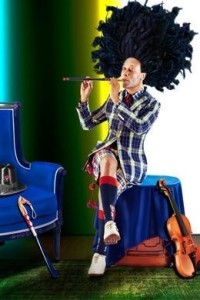
About:
What do you actually do all day? Mostly read, daydream and think of pictures
Favorite song growing up? Fela Kuti, James Brown, David Bowie, The Jacksons, Rock ‘n’ Roll, Jazz, Opera, etc.
Why do you live in NYC? It agrees with my artistic temperament
Uber, Taxi, Subway or Citi Bike? walking
My motto is… so bloody what?
My alter ego is… Jeandes Esseintes
Last drink I had was… Black Label, whisky
My secret crush is… none
What was your first job? I never had a job as an employee – not interested
If you had one day left in NYC what would you do? Lie down, listen to Bach’s Goldberg Variation on a loop over and over and over again.
Coming from? Going to? My studio, going back to my studio
What is your favorite work of art? I love Chardin’s, “Boy Blowing Bubbles”.
Who should we know? The Beautiful ones.
(From Guest of a Guest, August 14)
Review in New York Times of exhibition he had last year:
October 30, 2013
Iké Udé’: The Wildness of Clothes, but Not for Fashion
By MARY BILLARD
Iké Udé was standing inside the Lelia Heller Gallery in Chelsea in early October during the installation of his show, “Style and Sympathies.” The exhibition, was set to open the next day. Many works were in cartons, others leaning against the wall; a few were hung. There was the smell of fresh paint.
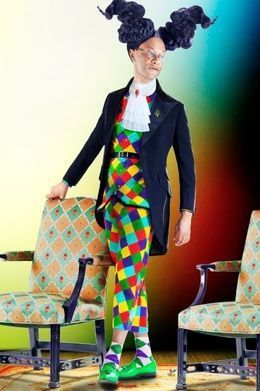 All photos are from the ‘Sartorial Anarchy’ series, 2013.
All photos are from the ‘Sartorial Anarchy’ series, 2013.
The artist paused in front of a self-portrait that hung near the entryway, a photograph in which he was outfitted in a plaid jacket from the George Burns movie “College Holiday,” a Soviet military commander armband and 17th-century French shoes with bows, an Ottoman-era Turkish headpiece. “I’m quite delighted,” he said. “It came out the way I imagined.”
Mr. Udé had been imagining these works since writing the words “Sartorial Anarchy” on the wall of his Chelsea apartment in 2003. A few pieces were included this spring in a show called “Artist/Rebel/Dandy: Men of Fashion” at the Museum of Art Rhode Island School of Design.
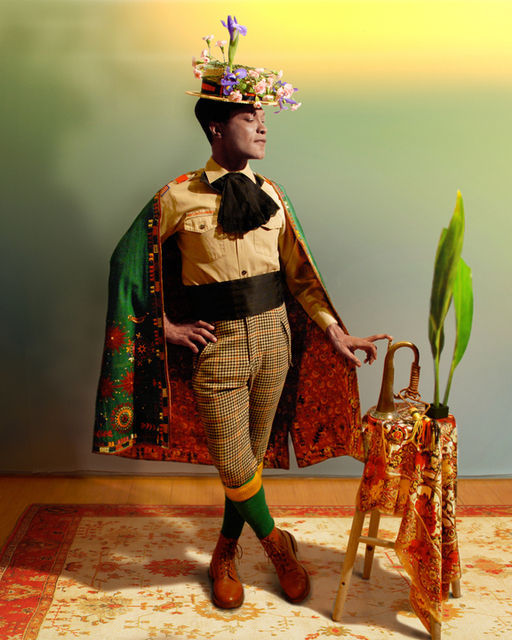
The lush color-laden photographs (he prefers the word “pictures”) are self-portraits of the artist in clothes designed to transcend time and place. “I don’t use clothes as fashion, it’s more of an indices of culture,” he said. “I’m quoting across geographies, cultures and time periods, back and forth. That’s why I say post-dandyism.”
The crinkling of discarded paper was heard as the unwrapped works were leaned against the wall by gallery workers. Does he consider himself a dandy? “By default.” Meaning? “I’ll leave it at that.”
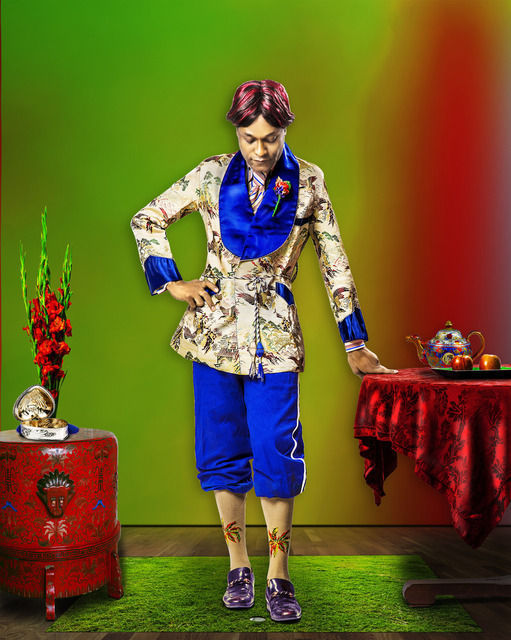
Mr. Udé, who was born in 1964, was raised in Lagos, Nigeria. Dressing for photographic portraits may be bred in the bone. His family dressed up to have their pictures taken twice a month. He has lived in New York since the 1980s. “I qualify as a New Yorker, if you allow,” he said, his accent and wording showing a trace of the former British colony.
The next night, after the show’s opening, there would be a very New York dinner at Bottino, the Chelsea art-world hangout, with Amy Fine Collins, special correspondent for Vanity Fair; Fern Mallis, the former executive director of the Council of Fashion Designers of America; the philanthropist Jean Shafiroff; the model Pat Cleveland, and the model-agent-activist Bethann Hardison among the fashionable attendees.

Mr. Udé has been named twice to the Vanity Fair International Best-Dressed List. At the gallery installation, the tall, model-thin artist was wearing a Rive Gauche brownish suit from 1999, by Hedi Slimane. He later admitted he had the jacket shortened. “An improvement on Slimane’s design,” he said with a sly side smile.
Mr. Udé stood in front of “Sartorial Anarchy #21.” Detachment ebbed away as he pointed out that the pants were Nigerian (1940s), the jacket was from England (1930s or 1940s) and an octopus’s tentacles hugged the hat. The artist commissioned a milliner to construct the octopus out of papier-mâché. “I love the lines of the octopus echo the lines on the jacket,” he said. “And the color here is balanced with the color here, all composed.”
At his studio, Mr. Udé staged the scenes, which were shot by a photographer he said was a “hired hand.” He painted the colorful backdrops. Nothing is left to chance: not the vibrant interlocking colors nor the patterns formed by his pose, the clothes and the various objects designed to create what he called “rhymes of shapes.”
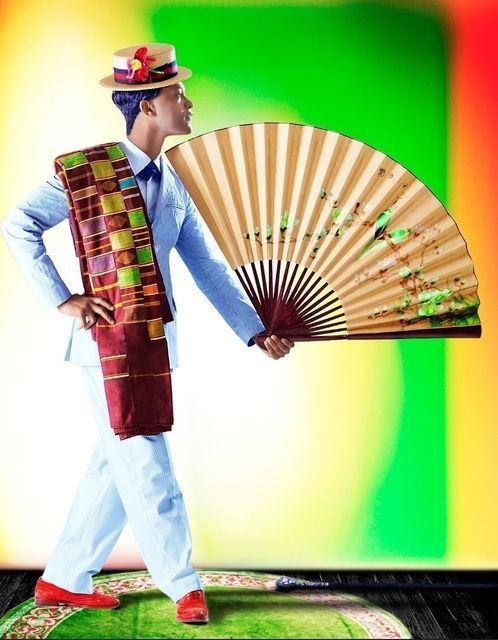
Mr. Udé kept an eye on the installation process going on around him, but kept most of his opinions to himself. “I believe, this is personally what I think, most artists are far too involved in placement of work,” he said. “I don’t find it advisable because I don’t have enough emotional distance from my work. I trust the gallery to be more objective to place the pictures where they belong.”
One touch he was responsible for: one wall was painted in red and an interior room in green. Mr. Udé and Lauren Pollock, the gallery director, thinking that they wanted something different from the uniform white background found in art galleries, had visited the Metropolitan Museum of Art for inspiration. Mr. Udé was pleased to see that the red wall, painted the previous day, worked well with his pictures. “My choice was informed by what I saw by the Met,” he said. “I love the fabric walls. If I had the money I would have used expensive fabric walls, just go all the way.”
Ms. Pollock came from the back office and explained the thought process that went into the placements of three photographs across the back wall. “We think this grouping is similar in quality in terms of mood,” she said.
Ms. Pollock hesitated before continuing: “I don’t know if this is a word you want to use, but we’ve been saying they have a little bit of surrealist quality in a way.”
She looked at the artist to gauge his reaction. He merely nodded.
She gestured toward the front of the gallery to a work showing Mr. Udé in a fantastic tall, orange powdered wig favored by the fashionable macaronis, a movement that was a precursor to dandyism. “We singled out ‘Sartorial Anarchy #5’ because it’s been one of Iké’s best known works to put in the front of the gallery,” Ms. Pollock said.
Again, she turned to Mr. Udé. “No, no. I have no opinion,” he said.
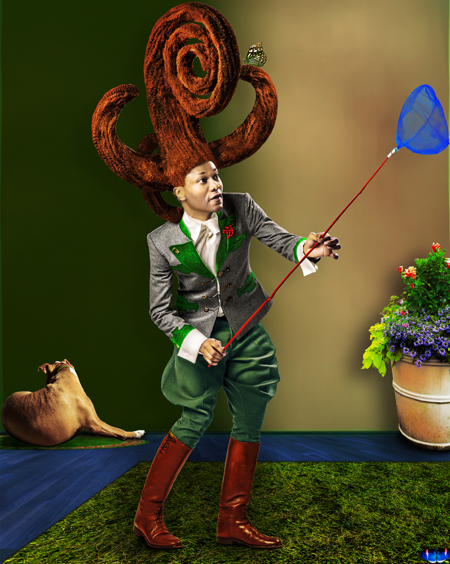
Michael Watson, the gallery preparator, was energetically opening the pictures and propping them against the wall. He moved on to a white cube where items in the pictures were going to be displayed. On top of it he placed an Uzbek traditional armor hat (circa 19th century); a French fencing mask (1940s); a reproduction of a Western European ruff-collar in white lace and cotton (16th century); and a Lord Byron costume mask, reproduced from an 1835 Thomas Phillips painting of the poet in Albanian dress.
Mr. Udé focused on the helmet. He was no longer aloof. “Are you going to leave this like this?” he asked.
Told that it could be displayed however the artist wanted, Mr. Udé pulled it up and gently moved it into a more upright position. “Yes, it shouldn’t be lying down,” he said. “It’s more beautiful this way.”
Courtesy: Leila Heller Callery
Copyright: Iké Udé.
